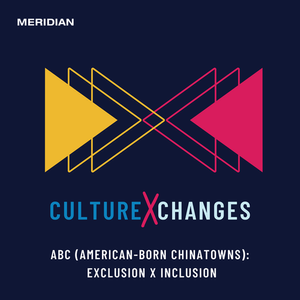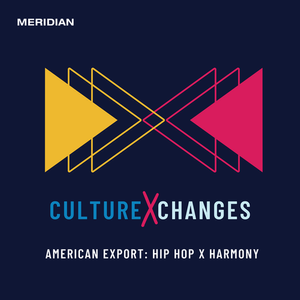
Chinatowns have played an instrumental role in the urban landscape as centers of influx, community, economic activity, and cultural preservation. These communities formed out of necessity, and the Chinese Exclusion Act of 1882 led to a boom in Chinese-owned businesses including restaurants. Today, there are more Chinese restaurants in the United States than there are McDonald’s, Pizza Huts, KFCs, Wendy’s, and Taco Bells, combined. On this episode of cultureXchanges, we speak to Lisa Mao and Penny Lee, whose documentary film A Tale of Three Chinatowns profiles Chinatowns in Washington, D.C., Chicago, and Boston to look at the forces affecting each urban community and the cultural impact of Chinatown on American cities.
Read the full transcript on our blog
Episode 2:

Next Level is an initiative of the U.S. Department of State, the University of North Carolina at Chapel Hill, and Meridian International Center. Its mission is to use hip hop music, dance, and art to foster cross-cultural creative exchange in diverse communities. The program works to promote understanding and conflict transformation in these audiences, and support the professional development of artists in those communities. It also builds on the historic legacy of the Department of State’s Jazz Ambassadors, who first traveled the world in the 1950s to connect with people through music.
On this episode of cultureXchanges, Next Level Founding Director, Dr. Mark Katz is joining us to discuss the history of global hip hop and how hip hop can be a bridge for cultural diplomacy.
Read the full transcript on our blog
Episode 3:

Treasures of Tutankhamun was one of the first international blockbuster exhibitions, but its success started with an act of cultural diplomacy that initiated the immense cooperation necessary to implement the international phenomenon. The exhibition began as a clause in an agreement between the United States and Egypt dedicated to cultural exchange; Egypt agreed to send Treasures of Tutankhamun on an American tour while the U.S. aided in the reconstruction of Cairo’s opera house. On this episode of cultureXchanges, we speak to Professor of Egyptology Dr. Aidan Dodson and Dr. Fatma Ismail, Director of U.S. Outreach and Programs at the American Research Center in Egypt on why this exhibition garnered global interest and how ‘The Boy King’ took hold of the public imagination.
Read the full transcript on our blog
Episode 4:

In 1958, at the age of 23, Texan pianist Van Cliburn won the inaugural International Tchaikovsky Competition in Moscow with his own arrangement of the beloved song “Moscow Nights.” Throughout his career, Cliburn continued to return to the Soviet Union for many televised performances and developed a lasting relationship with Soviet leader Nikita Khrushchev. On this episode of cultureXchanges, we speak with Maggie Estes, Director of Communication and Digital Content at the Cliburn Foundation on Cliburn’s legacy and how music plays a role in cultural diplomacy.
Read the full transcript on our blog
Episode 5:

Museums Connect was a joint initiative between the U.S. Department of State’s Bureau of Educational and Cultural Affairs and the American Alliance of Museums (AAM). This initiative partnered museums in the United States with museums abroad to help foster cross-cultural engagement and exchange. On this episode of cultureXchanges, we speak with Dr. Richard J.W. Harker, author of Museum Diplomacy: Transnational Public History and the U.S. Department of State, about this program and the role it played in connecting transnational public history with international diplomacy.
Read the full transcript on our blog
Episode 1:

The banjo is an instantly recognizable sound that has become synonymous with American folk music, a genre traditionally associated with white musicians. However, the banjo was originally created by enslaved Africans and their descendants in the Caribbean and North America, widely recognized as an African American tradition with a West African heritage. The banjo heard in American music is a distinct blend of West African and European cultures that widely differs from the West African banjo sound. On this episode of cultureXchanges, we speak with Kristina Gaddy to uncover the history of the banjo and how its sound has developed as a result of cultural exchange. Ms. Gaddy is a Baltimore-based writer and the author of Well of Souls: Uncovering the Banjo's Hidden History.
Read the full transcript on our blog
Episode 2:

From Madonna’s “Vogue” to the film Paris is Burning, Ballroom has made tremendous impacts on popular culture through dance, fashion, language, television, and music in the United States and abroad. While the beginnings of the Ballroom scene are typically attributed to 1980s New York, the roots of this culture have been traced back to the 19th century. Ballroom historically served, and still serves, as a space for Black and Brown LGBTQ+ individuals to build community through pageantry, dance, fashion, and performance while facing exclusion and danger in other nightlife and community spaces. On this episode of cultureXchanges we speak with Dr. Julian Kevon Glover, an academic, activist, and performer whose academic work focuses on Black and Brown queer cultural formations, performance, ethnography, embodied knowledge, and performance theory.
Read the full transcript on our blog
Episode 3:

Wampum, small beads made from shells, were at the center of diplomacy in North America in the early 17th century. The exchange of strings and belts adorned with wampum were diplomatic tokens, gifts, and most notably, treaty markers between Indigenous peoples and Europeans. On this episode of cultureXchanges we speak with Darren Bonaparte, cultural historian from the Akwesasne First Nation and current director of the Tribal Historic Preservation Office of the Saint Regis Mohawk Tribe.
Read the full transcript on our blog
Episode 4:

In 2001, the U.S. Department of State launched the Ambassadors Fund for Cultural Preservation (AFCP), a program to help preserve cultural heritage worldwide and to officially incorporate cultural preservation and protection into American diplomacy. AFCP supports international preservation projects that span a wide range of cultural heritage initiatives, including the preservation of historic buildings, archaeological sites, ethnographic objects, paintings, manuscripts, indigenous languages, and other forms of traditional cultural expression. Since 2001, the Fund has supported more than 1,000 projects in over 130 countries with local museums, ministries of culture, nonprofits, and other organizations. Furthermore, AFCP projects provide professional development for American cultural heritage professionals and students from nearly all 50 states. In this episode of cultureXchanges, we are speaking with Dr. Martin Perschler, program director for the Ambassadors Fund for Cultural Preservation at the U.S. Department of State.
Error: Button URL not defined.
Episode 5:

When taco trucks first arrived in the United States in the 1970s as workers from Mexico migrated to California, the menus combined Mexican food with American tastes. Now, food trucks are used for almost any cuisine imaginable and have revolutionized the way food is sold throughout the United States; however, Mexican food trucks have not always been welcomed by local governments, the public, and the culinary world. Today on cultureXchanges, we are having an engaging conversation with scholar and filmmaker Dr. Robert D. Lemon on the contribution of Mexican food trucks to urban space, public policy, and American cuisine.
Read the full transcript on our blog











